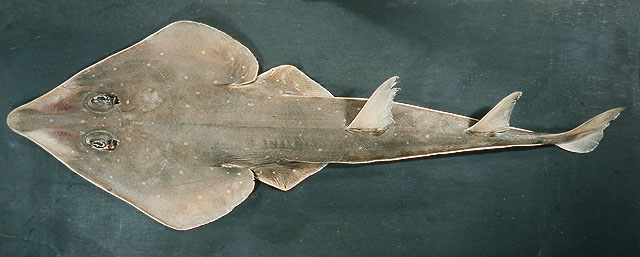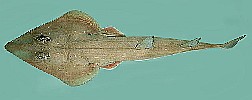Rhinobatos punctifer
Compagno & Randall, 1987
Spotted guitarfish
Classification: Elasmobranchii Rhinopristiformes Rhinobatidae
Reference of the original description
Rhinobatos punctifer, a new species of guitarfish (Rhinobatiformes: Rhinobatidae) from the Red Sea, with notes on the Red Sea batoid fauna. Proceedings of the California Academy of Sciences, (Series 4), 44(14), 335–342
Rhinobatos punctifer, a new species of guitarfish (Rhinobatiformes: Rhinobatidae) from the Red Sea, with notes on the Red Sea batoid fauna. Proceedings of the California Academy of Sciences, (Series 4), 44(14), 335–342
Image of the original description
Image in copyright.
Image in copyright.
Synonyms / new combinations and misspellings
Rhinobatos cf. punctifer
Rhinobatos cf. punctifer
Description :
Citation: Rhinobatos punctifer Compagno & Randall, 1987: In: Database of modern sharks, rays and chimaeras, www.shark-references.com, World Wide Web electronic publication, Version 01/2026
Please send your images of "Rhinobatos punctifer" to info@shark-references.com

Rhinobatos punctifer Compagno & Randall, 1987, © Randall, J.E, www.fish-base.org

Rhinobatos punctifer Compagno & Randall, 1987, © Randall, J.E, www.fish-base.org
Common names
 Spotted guitarfish
Spotted guitarfish
 Spotted guitarfish
Spotted guitarfish
Short Description
Diagnosis after Last et al. 2019 [27190]: A medium-sized species of the genus Rhinobatos (attaining at least 889 mm TL) distinguished by the following combination of characters: disc wedge-shaped, width 29–34% TL, length 1.2–1.3 times width; snout relatively short, length 2.2–2.6 times interspiracular distance, 3.6–3.9 times interorbital width in large males (2.9– 3.4 in females); orbit diameter 1.2–1.7 times spiracle length; nostrils weakly oblique, their length 1.3–1.9 times internarial distance; mouth narrow, width 5.4–5.6% TL in large males (5.8–6.2% in females); posterior nasal flaps broad; two spiracular folds, outermost fold slightly taller than inner fold; ridges of rostral cartilage almost parallel, converging slightly anteriorly but not constricted medially; anterior cartilage subtriangular to sickle shaped, usually blunt posteriorly; distance between fifth gill slits 2.8–3.1 times in ventral head length in large males (2.5–2.6 in females); prebranchial sensory pore patch obvious, extending to outer margin of first gill slit; postscapular sensory canal usually obvious, notched, with exposed lateral pores; inconspicuous thorn patches on supraorbit and scapular region, and single row along dorsal midline rudimentary; denticles confined to anterior portion of dorsal fins, posterior two-thirds naked; dorsal fins relatively tall, height of first 7.6–9.5% TL; pelvic-fin inner margin shorter than its base length; interdorsal distance 2.1–2.7 times first dorsal-fin base; dorsal caudal margin 2.1–2.2 times preventral margin; upper jaw with ~76 tooth rows; snout angle 60–75°; 69–75 pectoral radials; 175–184 post-synarcual centra; ~59 nasal lamellae; dorsal coloration highly variable, plain brownish to greenish brown, faintly or strongly marked with small white spots, ocellated, or with a combination of reticulations and ocelli; posterior half of dorsal and caudal fins usually dusky or blackish; snout with pale or dusky tip, but lacking long teardrop-shaped marking.
Diagnosis after Last et al. 2019 [27190]: A medium-sized species of the genus Rhinobatos (attaining at least 889 mm TL) distinguished by the following combination of characters: disc wedge-shaped, width 29–34% TL, length 1.2–1.3 times width; snout relatively short, length 2.2–2.6 times interspiracular distance, 3.6–3.9 times interorbital width in large males (2.9– 3.4 in females); orbit diameter 1.2–1.7 times spiracle length; nostrils weakly oblique, their length 1.3–1.9 times internarial distance; mouth narrow, width 5.4–5.6% TL in large males (5.8–6.2% in females); posterior nasal flaps broad; two spiracular folds, outermost fold slightly taller than inner fold; ridges of rostral cartilage almost parallel, converging slightly anteriorly but not constricted medially; anterior cartilage subtriangular to sickle shaped, usually blunt posteriorly; distance between fifth gill slits 2.8–3.1 times in ventral head length in large males (2.5–2.6 in females); prebranchial sensory pore patch obvious, extending to outer margin of first gill slit; postscapular sensory canal usually obvious, notched, with exposed lateral pores; inconspicuous thorn patches on supraorbit and scapular region, and single row along dorsal midline rudimentary; denticles confined to anterior portion of dorsal fins, posterior two-thirds naked; dorsal fins relatively tall, height of first 7.6–9.5% TL; pelvic-fin inner margin shorter than its base length; interdorsal distance 2.1–2.7 times first dorsal-fin base; dorsal caudal margin 2.1–2.2 times preventral margin; upper jaw with ~76 tooth rows; snout angle 60–75°; 69–75 pectoral radials; 175–184 post-synarcual centra; ~59 nasal lamellae; dorsal coloration highly variable, plain brownish to greenish brown, faintly or strongly marked with small white spots, ocellated, or with a combination of reticulations and ocelli; posterior half of dorsal and caudal fins usually dusky or blackish; snout with pale or dusky tip, but lacking long teardrop-shaped marking.
Distribution
Red Sea (Gulf of Aqaba, Israel), Persian Gulf, and the northern Arabian Sea to Pakistan (possibly further east into India) [27190] Source: www.gbif.org
Red Sea (Gulf of Aqaba, Israel), Persian Gulf, and the northern Arabian Sea to Pakistan (possibly further east into India) [27190] Source: www.gbif.org
Biology
Exhibit ovoviparity (aplacental viviparity), with embryos feeding initially on yolk, then receiving additional nourishment from the mother by indirect absorption of uterine fluid enriched with mucus, fat or protein through specialised structures [733]. Feeds on fish and invertebrates [20042].
Exhibit ovoviparity (aplacental viviparity), with embryos feeding initially on yolk, then receiving additional nourishment from the mother by indirect absorption of uterine fluid enriched with mucus, fat or protein through specialised structures [733]. Feeds on fish and invertebrates [20042].
Habitat
benthopelagic; marine
benthopelagic; marine
Remarks
shark-references Species-ID=5970;
shark-references Species-ID=5970;
Parasites (arranged by Jürgen Pollerspöck)
Cestoda
Cestoda
- Dollfusiella sp. [15730]
- Echinobothrium persiense Haseli, Malek, Palm & Ivanov, 2012 [16471] [19536]
- Eutetrarhynchus platycephali Palm, 2004 [15730]
- Parachristianella sp. [15730]
- Pseudochristianella southwelli Campbell & Beveridge, 1990 [15730]
- Trygonicola macroporus (Shipley & Hornell, 1906) [15730]

















